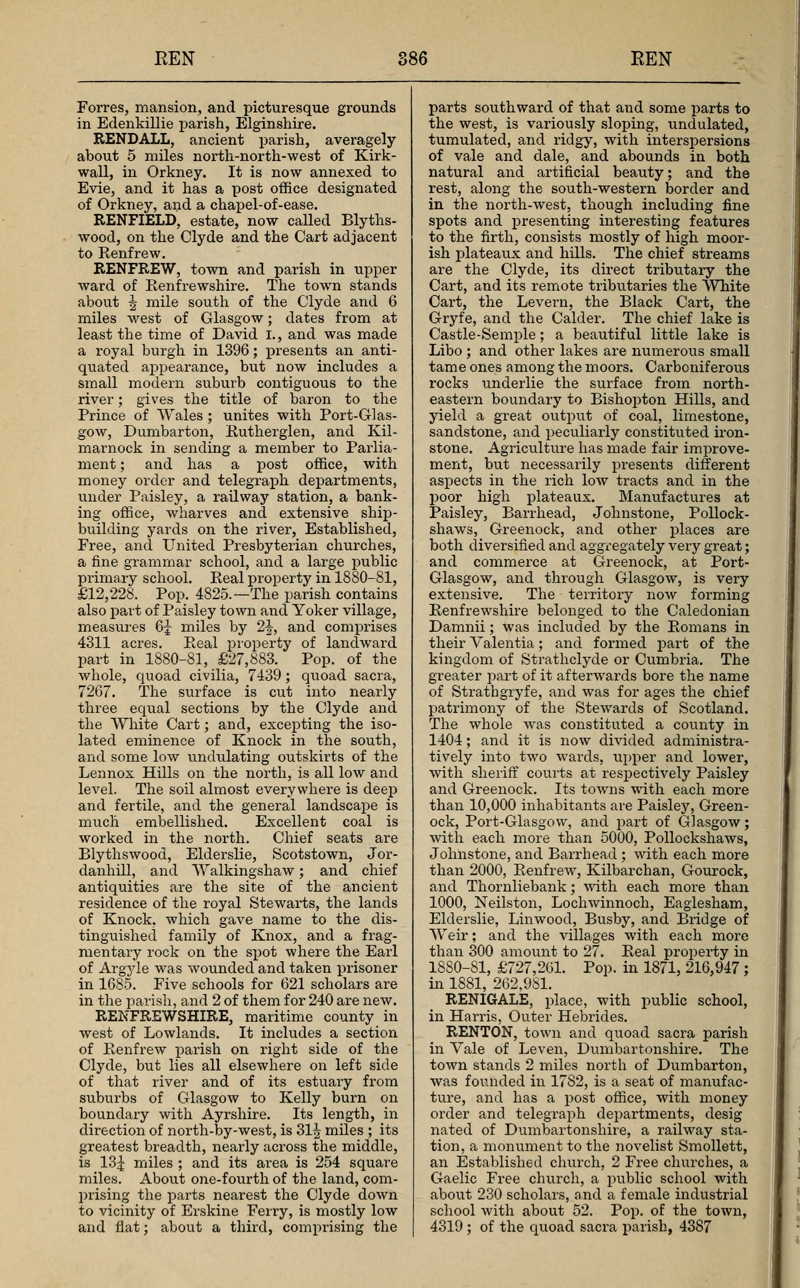RENDALL, ancient parish, averagely about 5 miles north-north-west of Kirkwall, in Orkney. It is now annexed to Evie, and it has a post office designated of Orkney, and a chapel-of-ease.
RENFIELD, estate, now called Blythswood, on the Clyde and the Cart adjacent to Kenfrew.
RENFREW, town and parish in upper ward of Renfrewshire. The town stands about % mile south of the Clyde and 6 miles west of Glasgow ; dates from at least the time of David I., and was made a royal burgh in 1396 ; presents an antiquated appearance, but now includes a small modern suburb contiguous to the river; gives the title of baron to the Prince of Wales ; unites with Port-Glasgow, Dumbarton, Eutherglen, and Kilmarnock in sending a member to Parliament ; and has a post office, with money order and telegraph departments, under Paisley, a railway station, a banking office, wharves and extensive ship-building yards on the river, Established, Free, and United Presbyterian churches, a fine grammar school, and a large public primary school. Real property in 1880-81, 12,228. Pop. 4825. The parish contains also part of Paisley town and Yoker village, measures 6 miles by 2J, and comprises 4311 acres. Real property of landward part in 1880-81, 27,883. Pop. of the whole, quoad civilia, 7439 ; quoad sacra, 7267. The surface is cut into nearly three equal sections by the Clyde and the White Cart; and, excepting the isolated eminence of Knock in the south, and some low undulating outskirts of the Lennox Hills on the north, is all low and level. The soil almost everywhere is deep and fertile, and the general landscape is much embellished. Excellent coal is worked in the north. Chief seats are Blythswood, Elderslie, Scotstown, Jordanhill, and Walkingshaw ; and chief antiquities are the site of the ancient residence of the royal Stewarts, the lands of Knock, which gave name to the distinguished family of Knox, and a fragmentary rock on the spot where the Earl of Argyle was wounded and taken prisoner in 1685. Five schools for 621 scholars are in the parish, and 2 of them for 240 are new.
RENFREWSHIRE, maritime county in west of Lowlands. It includes a section of Renfrew parish on right side of the Clyde, but lies all elsewhere on left side of that river and of its estuary from suburbs of Glasgow to Kelly burn on boundary with Ayrshire. Its length, in direction of north-by-west, is 31J miles ; its greatest breadth, nearly across the middle, is 13J miles ; and its area is 254 square miles. About one-fourth of the land, com-prising the parts nearest the Clyde down to vicinity of Erskine Ferry, is mostly low and flat ; about a third, comprising the parts southward of that and some parts to the west, is variously sloping, undulated, tumulated, and ridgy, with interspersions of vale and dale, and abounds in both natural and artificial beauty ; and the rest, along the south-western border and in the north-west, though including fine spots and presenting interesting features to the firth, consists mostly of high moor-ish plateaux and hills. The chief streams are the Clyde, its direct tributary the Cart, and its remote tributaries the White Cart, the Levern, the Black Cart, the Gryfe, and the Calder. The chief lake is Castle-Semple ; a beautiful little lake is Libo ; and other lakes are numerous small tame ones among the moors. Carboniferous rocks underlie the surface from north-eastern boundary to Bishopton Hills, and yield a great output of coal, limestone, sandstone, and peculiarly constituted iron-stone. Agriculture has made fair improvement, but necessarily presents different aspects in the rich low tracts and in the poor high plateaux. Manufactures at Paisley, Ban-head, Johnstone, Pollockshaws, Greenock, and other places are both diversified and aggregately very great ; and commerce at Greenock, at Port-Glasgow, and through Glasgow, is very extensive. The territory now forming Renfrewshire belonged to the Caledonian Damnii; was included by the Romans in their Valentia ; and formed part of the kingdom of Strathclyde or Cumbria. The greater part of it afterwards bore the name of Strathgryfe, and was for ages the chief patrimony of the Stewards of Scotland. The whole was constituted a county in 1404 ; and it is now divided administratively into two wards, upper and lower, with sheriff courts at respectively Paisley and Greenock. Its towns with each more than 10,000 inhabitants are Paisley, Greenock, Port-Glasgow, and part of Glasgow ; with each more than 5000, Pollockshaws, Johnstone, and Barrhead ; with each more than 2000, Renfrew, Kilbarchan, Gourock, and Thornliebank ; with each more than 1000, Neilston, Lochwinnoch, Eaglesham, Elderslie, Linwood, Busby, and Bridge of Weir ; and the villages with each more than 300 amount to 27. Real property in 1880-81, 727,261. Pop. in 1871, 216,947 ; in 1881, 262,981.
RENIGALE, place, with public school, in Harris, Outer Hebrides.
RENTON, town and quoad sacra parish in Vale of Leven, Dumbartonshire. The town stands 2 miles north of Dumbarton, was founded in 1782, is a seat of manufacture, and has a post office, with money order and telegraph departments, desig nated of Dumbartonshire, a railway station, a monument to the novelist Smollett, an Established church, 2 Free churches, a Gaelic Free church, a public school with about 230 scholars, and a female industrial school with about 52. Pop. of the town, 4319 ; of the quoad sacra parish, 43S7

